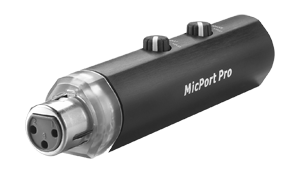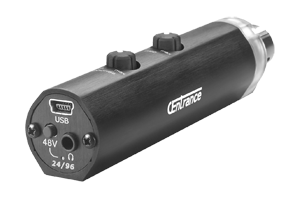MICPORT PRO
Presentation is certainly important, and CEntrance does not disappoint. The MicPort Pro comes nicely boxed, and includes a velvet pouch for transport and a six-foot USB cable. This is long enough so you can move your laptop far enough away to prevent fan or hard drive noise leaking into the live mic. The barrel of the unit is brushed aluminum anodized in black, and someone thought far enough ahead to give the barrel a flat spot so it won’t roll around on the table. Rubberized knobs for setting the mic level and the headphone level are then on top. When plugged in, the end of the MicPort Pro lights up as a white LED illuminates a collar around the XLR jack. An emergency flashlight perhaps, or just coolness?
 In addition to converting balanced audio into USB, the MicPort Pro is actually a full-blown microphone preamp with very good specs. According to the datasheet, the frequency response is 20 Hz to 20 kHz, plus or minus 1.5 dB, and has an EIN noise spec of -121 dB, A- weighted. A microphone level knob on the top of the unit will give you 36 dB of gain, which is more than enough for most condensers and was adequate for my RE-20. It’s not enough gain for a ribbon mic, but why would you be taking a ribbon mic on the road anyway?
In addition to converting balanced audio into USB, the MicPort Pro is actually a full-blown microphone preamp with very good specs. According to the datasheet, the frequency response is 20 Hz to 20 kHz, plus or minus 1.5 dB, and has an EIN noise spec of -121 dB, A- weighted. A microphone level knob on the top of the unit will give you 36 dB of gain, which is more than enough for most condensers and was adequate for my RE-20. It’s not enough gain for a ribbon mic, but why would you be taking a ribbon mic on the road anyway?
 As you may have guessed by now, the MicPort Pro also has full 48 V phantom power. Keep in mind that the MicPort Pro is entirely powered by USB, and requires no external power supply or batteries. And if that wasn’t enough, maxing out the headphone volume knob up will crank most headphones up to a reasonably high level. What you’ll hear in the cans is zero latency monitoring of your microphone signal. In other words, the incoming microphone signal goes directly to the headphone jack, as well as to the USB conversion circuits, so there’s no delay in your headphones.
As you may have guessed by now, the MicPort Pro also has full 48 V phantom power. Keep in mind that the MicPort Pro is entirely powered by USB, and requires no external power supply or batteries. And if that wasn’t enough, maxing out the headphone volume knob up will crank most headphones up to a reasonably high level. What you’ll hear in the cans is zero latency monitoring of your microphone signal. In other words, the incoming microphone signal goes directly to the headphone jack, as well as to the USB conversion circuits, so there’s no delay in your headphones.
IN USE
Setting up the MicPort Pro on a Macintosh is completely painless. You just plug it in, and it becomes available in your software. If you open the sound panel in your system preferences, you’ll see a new item listed as CEntrance MicPort Pro. There are no additional controls or software panels needed — you just go to work. It works with Mac OSX 10.4 as well as 10.5.
Things are slightly more complicated on a Windows machine, but only very slightly. The MicPort Pro works with both Windows XP and with Windows Vista, and will be recognized by plug-and-play as soon as you connect it. CEntrance has a driver for Windows that you should download and install, because it includes an ASIO driver with a panel that allows you to set the sample rate and latency. I also tried using the MicPort Pro on a Windows 2000 laptop, and I don’t recommend it, although neither does the company. Besides, if you’re not using either XP SP2 or Vista by now you’ve probably got some other problems with your rig.
So once you plug in the MicPort Pro and connect a microphone to it, all you’ll need to do is fire up your software editor and assign your audio input to the MicPort Pro. On the Macintosh I use the MicPort Pro with Amadeus Pro and with Peak, both of which were no-brainers. On the Windows side, I plugged it into Adobe Audition 3, WaveLab, and Cockos Reaper, and everything worked just as expected.
Since MicPort is entirely powered via USB, I thought it might be interesting to see how much power it draws under different conditions. I fired up a battery utility on my laptop that also reports total current draw, then connected the MicPort Pro to the USB jack. The utility’s current meter moved up from about 1.75 amps to around 2.0 amps, a difference of 250 milliamps. The USB spec says that the bus should be capable of producing 500 ma of current, so it follows that a laptop might be able to support two MicPort units. I also noted that the MicPort Pro was warm to the touch while in use.
I did not get the opportunity to check out the Aggregate option, which lets you combine multiple MicPort Pros into one interface using a hub, but I intend to in future. Incidentally, engaging the 48V phantom power with a condenser mic did not appreciably alter the current draw, but one wouldn’t expect much additional current for phantom anyway.
